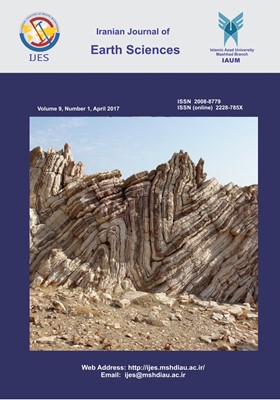Geochemistry of the Paleocene Sediments from SW Ahar: Implications for Provenance, Tectonics and Source Rock Weathering
محورهای موضوعی : Mineralogy
Nasser Ashrafi
1
![]() ,
Behzad Hajalilou
2
,
Behzad Hajalilou
2
1 - Geology depatment, Payame Noor University
2 - Geology Department, Payame Noor University
کلید واژه: SEM-EDX analysis, shale, interbedded siltstone, Neo-Tethyan subduction, Goouradaraq,
چکیده مقاله :
The mineralogy and geochemistry of Paleocene shales and interbedded siltstones in the southwestern of Ahar town (NW Iran) were studied by optical microscopy, XRD, SEM, XRF, and ICP-MS techniques. The mineralogical composition, mainly characterized by calcite, quartz, feldspar, dolomite, muscovite, magnesiohornblende, chlorite, illite, montmorionite, palygorskite, and koninckite, suggests relatively fast erosion of the parent rocks and incipient metamorphism for the studied sediments. The values of weathering indices and the Index of Compositional Variability, as well the mineralogy of the sediments imply moderate weathering in the parent rocks and deposition as first cycle sediments. The shales exhibit higher Al2O3/TiO2 (≈21), La/Sc, and Th/Cr values corresponding to felsic and/or intermediate source rocks. The geochemical character of sediments including ∑REE=116 ppm, (La/Yb)N=8.3, (Eu/Eu)=0.78, and the immobile elemental ratios values suggest an immature continental arc setting. The typical shale and chondrite normalized REE patterns of the shales are comparable with continental arc terrigenous sediments and Andean-type andesites. The inferred tectonic setting for the studied shale is in agreement with the tectonic evolutionary history of NW Iran during the Upper Cretaceous-Upper Paleocene. According to the present data, we conclude that the ultimate provenance of the studied shale and its interbedded siltstone and thin detritic limestone was probably the Upper Cretaceous sediments with the geoenvironment of acidic to intermediate volcanic rocks and marl.
The mineralogy and geochemistry of Paleocene shales and interbedded siltstones in the southwestern of Ahar town (NW Iran) were studied by optical microscopy, XRD, SEM, XRF, and ICP-MS techniques. The mineralogical composition, mainly characterized by calcite, quartz, feldspar, dolomite, muscovite, magnesiohornblende, chlorite, illite, montmorionite, palygorskite, and koninckite, suggests relatively fast erosion of the parent rocks and incipient metamorphism for the studied sediments. The values of weathering indices and the Index of Compositional Variability, as well the mineralogy of the sediments imply moderate weathering in the parent rocks and deposition as first cycle sediments. The shales exhibit higher Al2O3/TiO2 (≈21), La/Sc, and Th/Cr values corresponding to felsic and/or intermediate source rocks. The geochemical character of sediments including ∑REE=116 ppm, (La/Yb)N=8.3, (Eu/Eu)=0.78, and the immobile elemental ratios values suggest an immature continental arc setting. The typical shale and chondrite normalized REE patterns of the shales are comparable with continental arc terrigenous sediments and Andean-type andesites. The inferred tectonic setting for the studied shale is in agreement with the tectonic evolutionary history of NW Iran during the Upper Cretaceous-Upper Paleocene. According to the present data, we conclude that the ultimate provenance of the studied shale and its interbedded siltstone and thin detritic limestone was probably the Upper Cretaceous sediments with the geoenvironment of acidic to intermediate volcanic rocks and marl.


